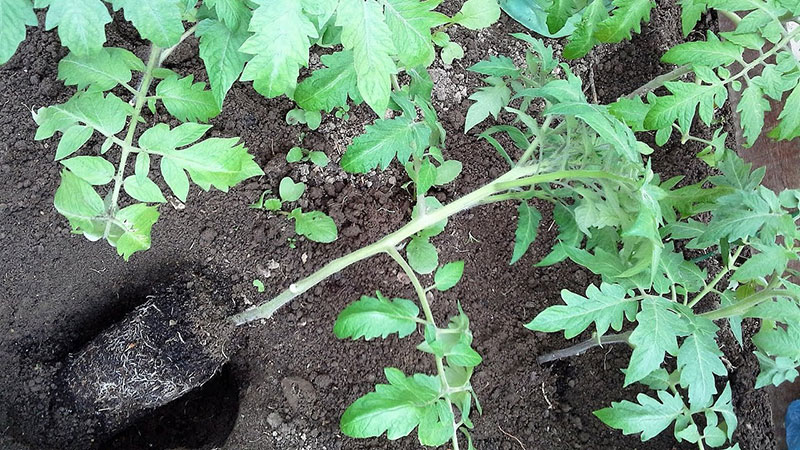Large-fruited and early ripe hybrid for universal use - tomato "Strega f1"
The hybrid tomato Strega f1 is in demand among gardeners due to its high yield and unpretentiousness in agricultural technology.
We will tell you in detail about growing tomato seedlings and further caring for the plant, as well as possible problems and ways to solve them.
The content of the article
Description of the hybrid
The main features of Strega tomatoes are tall bushes and form many stepchildren. The plant is not susceptible to fungal diseases, but in order to prevent it, it is necessary to remove the lower leaves up to 1/3 of the height of the bush.
Distinctive features
The Strega tomato is characterized by the following characteristics:

- early ripe large-fruited hybrid, indeterminate;
- 3 months pass from the first shoots to the appearance of fruits;
- the plant is strong, the internodes are short;
- the first inflorescences are laid over the ninth leaf plate;
- up to 6 fruits are formed in one brush, while on the upper brushes the size of the tomatoes is preserved;
- suitable for growing in all types of greenhouses, as well as outdoors.
Fruit characteristics, yield indicators
The fruit of the Strega f1 hybrid has the following features:
- the shape of the tomatoes is round, they are flat above and below;
- medium-silver;
- fruit color is deep red;
- the mass of one tomato reaches 200–250 g;
- the fruits are dense, while their flesh is fleshy, juicy.
Reference! The yield of Strega tomato per 1 square meter is 20-25 kg.
How to grow seedlings
Sowing seeds is carried out no earlier than 60 days before planting in open ground. Only in this case you can grow beautiful, healthy, but not overgrown seedlings.
Seed preparation
Hybrid seeds do not need to be cullable. However, it will not be superfluous to disinfect the seed.
There are several options for carrying out this procedure:
- in a weak solution of potassium permanganate, lower the seeds placed in a gauze bag;
- soak the seeds in Fitosporin solution;
- soak the seeds in a soda solution (a teaspoon of soda per glass of water) - this procedure will not only destroy pathogens, but also accelerate the emergence of seedlings.
After disinfection, the seeds are recommended to be dipped into a growth stimulator for a day.
Attention! For the preparation of solutions, use settled, rain or melt water.
Capacity and soil
Ready-made potting soil for indoor plants is suitable for growing seedlings. You can also prepare the soil mixture yourself.
This requires the following components:
- peat;
- compost or humus;
- turf or leafy land;
- sand (it is best to take river sand - it is largest).
Reference! Sand is taken half as much as other components.
A glass of wood ash is added to 10 liters of soil mixture (can be replaced with crushed chalk), as well as a tablespoon of mineral fertilizers. All components are thoroughly mixed.
The substrate also needs to be disinfected. To do this, it is placed in an oven preheated to 100 ° C for 60 minutes.
It is best to choose peat pots, tablets or special boxes and cassettes for seedlings as a container for planting.
Sowing
Small holes are made at the bottom of the landing container. After that, soil is poured there.The seeds are planted in the ground to a depth of 1 cm, with the distance between the seeds being 3 cm. You can put 3-6 seeds in peat pots, and 2-4 in tablets.
It is better to spill the soil with water in advance so that the flow of water does not wash out the seeds. The containers are covered with foil or glass and placed in a warm room. The optimum temperature for seeds is 28–30 ° C.
Attention! You cannot put containers on batteries.
The film is opened for a few minutes every day. With the appearance of the first shoots, it is removed.
Growing and caring for seedlings
With the appearance of the first shoots, the seedlings are transferred to a cool place with a temperature of 16-18 ° C. After 7-10 days, the sprouts are transferred back to a warm place with a temperature of 20-22 ° C, at night it should be cooler - 14-16 ° C.
Important! Protect seedlings from drafts.
 Seedling care rules:
Seedling care rules:
- Watering... The roots of tomato seedlings are tender, so water the sprouts carefully, along the edges of the container, use a watering can without a nozzle. It is also necessary to spray the plant once a day, twice on dry days.
- Lighting... Young sprouts need a lot of light, so it is recommended to put the seedlings on the southern windowsill or loggia. With a lack of natural light, a phytolamp is used. Periodically, the containers are turned so that the plants do not stretch in one direction.
- Dive. If the seedlings are too dense, they need to be planted immediately after the first leaves appear. The sprouts are transplanted to a depth of 3-4 cm with a distance of 5–7 cm between them. The seedlings dive together with an earthen lump. After 20-22 days, a second dive is carried out in a larger container.
- Top dressing... After 15–20 days after the first shoots, the seedlings are fed. Top dressing is carried out regularly, every 10 days. You can choose ready-made complex fertilizers, or you can take wood ash, eggshells or chicken droppings.
Reference! Fertilizers are applied after moistening the soil in the morning or evening hours.
How to grow tomatoes
To grow a rich and tasty harvest of Strega f1 tomatoes, follow our recommendations.
Landing
It is best to plant seedlings in open ground in cloudy weather or in the evening. The distance between the rows is 50–70 cm, and the sprouts are spaced 30–40 cm apart.
Landing Algorithm:
- Make holes 15 cm deep.
- Spill each well with plenty of water.
- Plant the seedlings, deepening them to the cotyledonous leaves.
- Sprinkle the seedlings with soil, compact it so that the sprouts do not fall.
Important! Overgrown seedlings are tied to pegs.
Seedling care
Basic procedures for a rich harvest:
- Watering. There is no need to water the first week after planting the seedlings, because the sprouts need to take root. Then watering is carried out as the soil dries up. The optimal water consumption for 1 bush is 2–5 liters. Tomatoes are watered only at the root, not on top. It is recommended to loosen the field of each soil moisture.
- Top dressing... The first time fertilizers are applied 15–20 days after transplanting. To do this, use ready-made complex formulations, prepare a solution in accordance with the instructions. The second time tomatoes are fed after the first flowering and during the period of bud formation. The third time is fertilized at the time of the appearance of the first fruits.
- Stealing and pruning... Stepsons take nutrients from plants, so they need to be removed. If this is not done, the growth of tomatoes and their fruiting slows down, and may even stop altogether. Experts advise to get rid of unnecessary processes solely with your fingers, without using pruning shears and scissors, while leaving hemp 1 cm long. Also, in the Strega hybrid, they get rid of the lower leaves - this procedure is performed after the first ovaries appear. The lower leaves are trimmed with pruning shears or scissors.
- Garter... As soon as the bush grows above 50 cm, it is recommended to tie it up. It is best to use trellises.
Features of cultivation and possible difficulties
In equipped greenhouses, Strega tomato f1 is grown even in winter. The culture is unpretentious to climatic conditions.
In the open field, it is not recommended to plant seedlings in a sunny place, otherwise the leaf plates will be burned. It is better to choose partial shade. Tomatoes must be protected from drafts. Do not plant seedlings in wetlands. This will cause the stems and leaves to rot.
Diseases and pests
It is worth worrying if spots appear on the leaf plates and fruits. The appearance of mold on the leaves is also dangerous. If such diseases occur, the affected parts must be removed, and then the plant must be treated with fungicides.
The hybrid is resistant to the following diseases:
- fusarium;
- withering;
- late blight;
- tobacco mosaic virus.
The best remedies for tomato diseases are prevention (disinfection of seeds and soil, loosening, weeding) and proper agricultural technology.
The nuances of growing in an open field and a greenhouse
When growing Strega tomatoes, the following points should be considered:
- sowing seeds is carried out in mid-March;
- a week before planting seedlings, it must be hardened;
- in May, it is better to plant seedlings under a film, in June - in open ground;
- the plant needs constant watering, feeding and loosening.
In a greenhouse, plantings need regular ventilation. To improve pollination, the bushes are recommended to be shaken periodically.
Harvesting and application of the crop
They begin to harvest in early August and continue to harvest ripe tomatoes until mid-September.
Most often, Strega tomatoes are used fresh, they are well suited for appetizers, salads and sandwiches. Tomatoes can also be used to make hot sauces and soups.

Advantages and disadvantages of the view
The main advantages of the Strega f1 hybrid:
- good formation of ovaries at different temperatures;
- excellent taste;
- marketable type and transportability;
- resistance to many diseases.
Agronomists did not reveal any serious shortcomings in Strega tomato.
Farmers reviews
Sergey, Belgorod: “I plant a Strega f1 hybrid every year for sale. These tomatoes are the first to be taken apart from me. I use mulch to keep moisture in the soil. "
Natalia, Vladimir: “I planted Strega for the first time on the recommendation of a friend. I watered the tomatoes abundantly, three times a week. The harvest result exceeded all my expectations. The tomatoes are smooth, beautiful, like in the photo of the package with seeds. "
Evgeniya, Zlatoust: “Strega produces an excellent harvest even in a bad year. Bushes grow powerful, delight with an abundance of ovaries. I plant tomatoes at a distance of 1 m from each other. "
Conclusion
Tomato Strega f1 is a real find for gardeners. The hybrid does not require special growing conditions, is unpretentious to climatic conditions, but at the same time it gives a rich harvest of beautiful and tasty fruits.
Tomatoes have an excellent presentation and tolerate transportation well. Suitable both for fresh consumption and for sauces and soups.